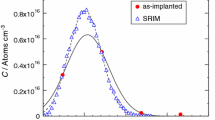Abstract.
Volume diffusion rates of Ce, Sm, Dy, and Yb have been measured in a natural pyrope-rich garnet single crystal (Py71Alm16Gr13) at a pressure of 2.8 GPa and temperatures of 1,200–1,450 °C. Pieces of a single gem-quality pyrope megacryst were polished, coated with a thin layer of polycrystalline REE oxide, then annealed in a piston cylinder device for times between 2.6 and 90 h. Diffusion profiles in the annealed samples were measured by SIMS depth profiling. The dependence of diffusion rates on temperature can be described by the following Arrhenius equations (diffusion coefficients in m2/s): % MathType!MTEF!2!1!+- % feaaeaart1ev0aaatCvAUfKttLearuavTnhis1MBaeXatLxBI9gBam % XvP5wqSXMqHnxAJn0BKvguHDwzZbqegm0B1jxALjhiov2DaeHbuLwB % Lnhiov2DGi1BTfMBaebbfv3ySLgzGueE0jxyaibaieYlf9irVeeu0d % Xdh9vqqj-hEeeu0xXdbba9frFj0-OqFfea0dXdd9vqaq-JfrVkFHe9 % pgea0dXdar-Jb9hs0dXdbPYxe9vr0-vr0-vqpWqaaeaabiGaciaaca % qabeaadaabauaaaOqaauaabeqaeeaaaaqaaiGbcYgaSjabc+gaVjab % cEgaNnaaBaaaleaacqaIXaqmcqaIWaamaeqaaOGaemiraq0aaSbaaS % qaaiabbMfazjabbkgaIbqabaGccqGH9aqpcqGGOaakcqGHsislcqaI % 3aWncqGGUaGlcqaI3aWncqaIZaWmcqGHXcqScqaIWaamcqGGUaGlcq % aI5aqocqaI3aWncqGGPaqkcqGHsisldaqadaqaaiabiodaZiabisda % 0iabiodaZiabgglaXkabiodaZiabicdaWiaaysW7cqqGRbWAcqqGkb % GscaaMe8UaeeyBa0Maee4Ba8MaeeiBaW2aaWbaaSqabeaacqqGTaql % cqqGXaqmaaGccqGGVaWlcqaIYaGmcqGGUaGlcqaIZaWmcqaIWaamcq % aIZaWmcqWGsbGucqWGubavaiaawIcacaGLPaaaaeaacyGGSbaBcqGG % VbWBcqGGNbWzdaWgaaWcbaGaeGymaeJaeGimaadabeaakiabdseaen % aaBaaaleaacqqGebarcqqG5bqEaeqaaOGaeyypa0JaeiikaGIaeyOe % I0IaeGyoaKJaeiOla4IaeGimaaJaeGinaqJaeyySaeRaeGimaaJaei % Ola4IaeGyoaKJaeG4naCJaeiykaKIaeyOeI0YaaeWaaeaacqaIZaWm % cqaIWaamcqaIYaGmcqGHXcqScqaIZaWmcqaIWaamcaaMe8Uaee4AaS % MaeeOsaOKaaGjbVlabb2gaTjabb+gaVjabbYgaSnaaCaaaleqabaGa % eeyla0IaeeymaedaaOGaei4la8IaeGOmaiJaeiOla4IaeG4mamJaeG % imaaJaeG4mamJaemOuaiLaemivaqfacaGLOaGaayzkaaaabaGagiiB % aWMaei4Ba8Maei4zaC2aaSbaaSqaaiabigdaXiabicdaWaqabaGccq % WGebardaWgaaWcbaGaee4uamLaeeyBa0gabeaakiabg2da9iabcIca % OiabgkHiTiabiMda5iabc6caUiabikdaYiabigdaXiabgglaXkabic % daWiabc6caUiabiMda5iabiEda3iabcMcaPiabgkHiTmaabmaabaGa % eG4mamJaeGimaaJaeGimaaJaeyySaeRaeG4mamJaeGimaaJaaGjbVl % abbUgaRjabbQeakjaaysW7cqqGTbqBcqqGVbWBcqqGSbaBdaahaaWc % beqaaiabb2caTiabbgdaXaaakiabc+caViabikdaYiabc6caUiabio % daZiabicdaWiabiodaZiabdkfasjabdsfaubGaayjkaiaawMcaaaqa % aiGbcYgaSjabc+gaVjabcEgaNnaaBaaaleaacqaIXaqmcqaIWaamae % qaaOGaemiraq0aaSbaaSqaaiabboeadjabbwgaLbqabaGccqGH9aqp % cqGGOaakcqGHsislcqaI5aqocqGGUaGlcqaI3aWncqaI0aancqGHXc % qScqaIYaGmcqGGUaGlcqaI4aaocqaI0aancqGGPaqkcqGHsisldaqa % daqaaiabikdaYiabiIda4iabisda0iabgglaXkabiMda5iabigdaXi % aaysW7cqqGRbWAcqqGkbGscaaMe8UaeeyBa0Maee4Ba8MaeeiBaW2a % aWbaaSqabeaacqqGTaqlcqqGXaqmaaGccqGGVaWlcqaIYaGmcqGGUa % GlcqaIZaWmcqaIWaamcqaIZaWmcqWGsbGucqWGubavaiaawIcacaGL % Paaaaaaaaa!0C76! \(\matrix{ {\log _{10} D_{{\rm Yb}} = ( - 7.73 \pm 0.97) - \left( {343 \pm 30\;{\rm kJ}\;{\rm mol}^{{\rm - 1}} /2.303RT} \right)} \cr {\log _{10} D_{{\rm Dy}} = ( - 9.04 \pm 0.97) - \left( {302 \pm 30\;{\rm kJ}\;{\rm mol}^{{\rm - 1}} /2.303RT} \right)} \cr {\log _{10} D_{{\rm Sm}} = ( - 9.21 \pm 0.97) - \left( {300 \pm 30\;{\rm kJ}\;{\rm mol}^{{\rm - 1}} /2.303RT} \right)} \cr {\log _{10} D_{{\rm Ce}} = ( - 9.74 \pm 2.84) - \left( {284 \pm 91\;{\rm kJ}\;{\rm mol}^{{\rm - 1}} /2.303RT} \right)} \cr } \) . There is no significant influence of ionic radius on diffusion rates; at each temperature the diffusion coefficients for Ce, Sm, Dy, and Yb are indistinguishable from each other within the measurement uncertainty. However, comparison with other diffusion data suggests that there is a strong influence of ionic charge on diffusion rates in garnet, with REE3+ diffusion rates more than two orders of magnitude slower than divalent cation diffusion rates. This implies that the Sm–Nd isotopic chronometer may close at significantly higher temperatures than thermometers based on divalent cation exchange, such as the garnet–biotite thermometer. REE diffusion rates in pyrope are similar to Yb and Dy diffusion rates in diopside at temperatures near the solidus of garnet lherzolite (~1,450 °C at 2.8 GPa), and are an order of magnitude faster than Nd, Ce, and La in high-Ca pyroxene at these conditions. At lower temperatures relevant to the lithospheric mantle and crust, REE diffusion rates in garnet are much faster than in high-Ca pyroxene, and closure temperatures for Nd isotopes in slowly-cooled garnets are ~200 °C lower than in high-Ca pyroxene.
Similar content being viewed by others
Author information
Authors and Affiliations
Additional information
Electronic Publication
Rights and permissions
About this article
Cite this article
Van Orman, J.A., Grove, T.L., Shimizu, N. et al. Rare earth element diffusion in a natural pyrope single crystal at 2.8 GPa. Contrib Mineral Petrol 142, 416–424 (2002). https://doi.org/10.1007/s004100100304
Received:
Accepted:
Issue Date:
DOI: https://doi.org/10.1007/s004100100304




